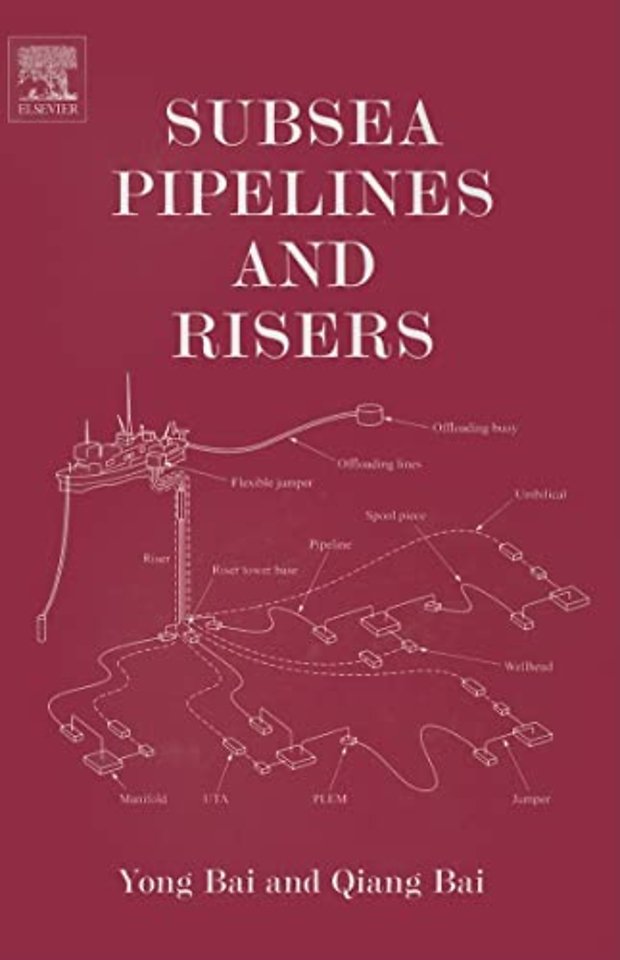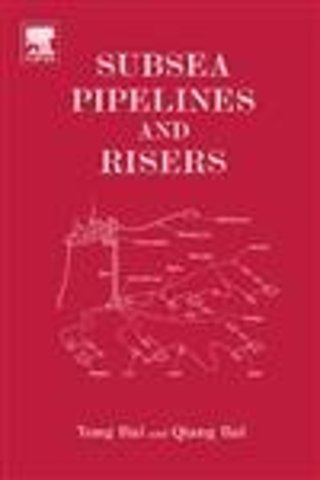<br>Table of contents</br><br>Foreword </br><br>Foreword to "Pipelines and Risers" Book </br><br>Preface </br><br>Part I: Mechanical Design</br><br> Chapter 1 Introduction </br><br> 1.1 Introduction </br><br> 1.2 Design Stages and Process </br><br> 1.3 Design Through Analysis (DTA) </br><br> 1.4 Pipeline Design Analysis </br><br> 1.5 Pipeline Simulator </br><br> 1.6 References </br><br> Chapter 2 Wall-thickness and Material Grade Selection </br><br> 2.1 Introduction </br><br> 2.2 Material Grade Selection </br><br> 2.3 Pressure Containment (hoop stress) Design </br><br> 2.4 Equivalent Stress Criterion </br><br> 2.5 Hydrostatic Collapse </br><br> 2.6 Wall Thickness and Length Design for Buckle Arrestors </br><br> 2.7 Buckle Arrestor Spacing Design </br><br> 2.8 References </br><br> Chapter 3 Buckling/Collapse of Deepwater Metallic Pipes </br><br> 3.1 Introduction </br><br> 3.2 Pipe Capacity under Single Load </br><br> 3.3 Pipe Capacity under Couple Load </br><br> 3.4 Pipes under Pressure Axial Force and Bending </br><br> 3.5 Finite Element Model </br><br> 3.6 References </br><br> Chapter 4 Limit-state based Strength Design </br><br> 4.1 Introduction </br><br> 4.2 Out of Roundness Serviceability Limit </br><br> 4.3 Bursting </br><br> 4.4 Local Buckling/Collapse </br><br> 4.5 Fracture </br><br> 4.6 Fatigue </br><br> 4.7 Ratcheting </br><br> 4.8 Dynamic Strength Criteria </br><br> 4.9 Accumulated Plastic Strain </br><br> 4.10 Strain Concentration at Field Joints Due to Coatings </br><br> 4.11 References </br><br>Part II: Pipeline Design</br><br> Chapter 5 Soil and Pipe Interaction </br><br> 5.1 Introduction 83</br><br> 5.2 Pipe Penetration in Soil 83</br><br> 5.3 Modeling Friction and Breakout Forces </br><br> 5.4 References </br><br> Chapter 6 Hydrodynamics around Pipes </br><br> 6.1 Wave Simulators</br><br> 6.2 Choice of Wave Theory</br><br> 6.3 Mathematical Formulations Used in the Wave Simulators</br><br> 6.4 Steady Currents </br><br> 6.5 Hydrodynamic Forces </br><br> 6.6 References </br><br> Chapter 7 Finite Element Analysis of In-situ Behavior </br><br> 7.1 Introduction 101</br><br> 7.2 Description of the Finite Element Model </br><br> 7.3 Steps in an Analysis and Choice of Analysis Procedure </br><br> 7.4 Element Types Used in the Model </br><br> 7.5 Non-linearity and Seabed Model </br><br> 7.6 Validation of the Finite Element Model </br><br> 7.7 Dynamic Buckling Analysis </br><br> 7.8 Cyclic In-place Behaviour during Shutdown Operations </br><br> 7.9 References </br><br> Chapter 8 Expansion, Axial Creeping, Upheaval/Lateral Buckling </br><br> 8.1 Introduction </br><br> 8.2 Expansion </br><br> 8.3 Axial Creeping of Flowlines Caused by Soil Ratcheting </br><br> 8.4 Upheaval Buckling </br><br> 8.5 Lateral Buckling </br><br> 8.6 Interaction between Lateral and Upheaval Buckling </br><br> 8.7 References </br><br> Chapter 9 On-bottom Stability </br><br> 9.1 Introduction </br><br> 9.2 Force Balance: the Simplified Method </br><br> 9.3 Acceptance Criteria </br><br> 9.4 Special Purpose Program for Stability Analysis </br><br> 9.5 Use of FE Analysis for Intervention Design </br><br> 9.6 References </br><br> Chapter 10 Vortex-induced Vibrations (VIV) and Fatigue </br><br> 10.1 Introduction </br><br> 10.2 Free-span VIV Analysis Procedure </br><br> 10.3 Fatigue Design Criteria </br><br> 10.4 Response Amplitude </br><br> 10.5 Modal Analysis </br><br> 10.6 Example Cases </br><br> 10.7 References </br><br> Chapter 11 Force Model and Wave Fatigue </br><br> 11.1 Introduction </br><br> 11.2 Fatigue Analysis </br><br> 11.3 Force Model </br><br> 11.4 Comparisons of Frequency Domain and Time Domain Approaches </br><br> 11.5 Conclusions and Recommendations </br><br> 11.6 References </br><br> Chapter 12 Trawl Impact, Pullover and Hooking Loads </br><br> 12.1 Introduction </br><br> 12.2 Trawl Gears </br><br> 12.3 Acceptance Criteria </br><br> 12.4 Impact Response Analysis </br><br> 12.5 Pullover Loads </br><br> 12.6 Finite Element Model for Pullover Response Analyses </br><br> 12.7 Case Study </br><br> 12.8 References </br><br> Chapter 13 Pipe-in-pipe and Bundle Systems </br><br> 13.1 Introduction </br><br> 13.2 Pipe-in-pipe System </br><br> 13.3 Bundle System </br><br> 13.4 References </br><br> Chapter 14 Seismic Design </br><br> 14.1 Introduction </br><br> 14.2 Pipeline Seismic Design Guidelines </br><br> 14.3 Conclusions </br><br> 14.4 References </br><br> Chapter 15 Corrosion Prevention </br><br> 15.1 Introduction </br><br> 15.2 Fundamentals of Cathodic Protection </br><br> 15.3 Pipeline Coatings </br><br> 15.4 CP Design Parameters</br><br> 5.5 Galvanic Anodes System Design </br><br> 15.6 References </br><br> Chapter 16 Asgard Flowlines Design Examples </br><br> 16.1 Introduction </br><br> 16.2 Wall-thickness and Linepipe Material Selection </br><br> 16.3 Limit State Strength Criteria </br><br> 16.4 Installation and On-bottom Stability </br><br> 16.5 Design for Global Buckling, Fishing Gear Loads and VIV </br><br> 16.6 Asgard Transport Project </br><br> 16.7 References </br><br>Part III: Flow Assurance</br><br> Chapter 17 Subsea System Engineering </br><br> 17.1 Introduction </br><br> 17.2 Typical Flow Assurance Process </br><br> 17.3 System Design and Operability </br><br> 17.4 References </br><br> Chapter 18 Hydraulics </br><br> 18.1 Introduction </br><br> 18.2 Composition and Properties of Hydrocarbons </br><br> 18.3 Emulsion </br><br> 18.4 Phase Behavior </br><br> 18.5 Hydrocarbon Flow </br><br> 18.6 Slugging and Liquid Handling </br><br> 18.7 Pressure Surge </br><br> 18.8 Line Sizing</br><br> 18.9 References </br><br> Chapter 19 Heat Transfer and Thermal Insulation </br><br> 19.1 Introduction </br><br> 19.2 Heat Transfer Fundamentals </br><br> 19.3 U-value </br><br> 19.4 Steady State Heat Transfer </br><br> 19.5 Transient Heat Transfer </br><br> 19.6 Thermal Management Strategy and Insulation </br><br> 19.7 References </br><br> 19.8 Appendix: U-value and Cooldown Time Calculation Sheet </br><br> Chapter 20 Hydrates </br><br> 20.1 Introduction</br><br> 20.2 Physics and Phase Behavior </br><br> 20.3 Hydrate Prevention </br><br> 20.4 Hydrate Remediation </br><br> 20.5 Hydrate Control Design Philosophies </br><br> 20.6 Recover of Thermodynamic Hydrate Inhibitors </br><br> 20.7 References </br><br> Chapter 21 Wax and Asphaltenes </br><br> 21.1 Introduction </br><br> 21.2 Wax </br><br> 21.3 Wax Management </br><br> 21.4 Wax Remediation </br><br> 21.5 Asphaltenes </br><br> 21.7 References </br><br>Part IV: Riser Engineering</br><br> Chapter 22 Design of Deepwater Risers </br><br> 22.1 Description of a Riser System </br><br> 22.2 Riser Analysis Tools </br><br> 22.3 Steel Catenary Riser for Deepwater Environments </br><br> 22.4 Stresses and Service Life of Flexible Pipes </br><br> 22.5 Drilling and Workover Risers </br><br> 22.6 Reference</br><br> Chapter 23 Design Codes for Risers and Subsea Systems </br><br> 23.1 Introduction </br><br> 23.2 Design Criteria for Deepwater Metallic Risers </br><br> 23.3 Limit State Design Criteria </br><br> 23.4 Loads, Load Effects and Load Cases</br><br> 23.5 Improving Design Codes and Guidelines </br><br> 23.6 Regulations and Standards for Subsea Production Systems </br><br> 23.7 References </br><br> Chapter 24 VIV and Wave Fatigue of Risers </br><br> 24.1 Introduction </br><br> 24.2 Fatigue Causes </br><br> 24.3 Riser VIV Analysis and Suppression </br><br> 24.4 Riser Fatigue due to Vortex-induced Hull Motions (VIM)</br><br> 24.5 Challenges and Solutions for Fatigue Analysis </br><br> 24.6 Conclusions </br><br> 24.7 References </br><br> Chapter 25 Steel Catenary Risers </br><br> 25.1 Introduction </br><br> 25.2 SCR Technology Development History </br><br> 25.3 Material Selection, Wall-thickness Sizing, Source Services and Clap Pipe </br><br> 25.4 SCR Design Analysis </br><br> 25.5 Welding Technology, S-N Curves and SCF for Welded Connections </br><br> 25.6 UT Inspections and ECA Criteria </br><br> 25.7 Flexjoints, Stressjoints and Pulltubes </br><br> 25.8 Strength Design Challenges and Solutions </br><br> 25.9 Fatigue Design Challenges and Solutions </br><br> 25.10 Installation and Sensitivity Considerations </br><br> 25.11 Integrity Monitoring and Management Systems </br><br> 25.12 References </br><br> Chapter 26 Top Tensioned Risers </br><br> 26.1 Introduction </br><br> 26.2 Top Tension Risers Systems </br><br> 26.3 TTR Riser Components </br><br> 26.4 Modelling and Analysis of Top Tensioned Risers </br><br> 26.5 Integrated Marine Monitoring System </br><br> 26.6 References </br><br> Chapter 27 Steel Tube Umbilical & Control Systems </br><br> 27.1 Introduction </br><br> 27.2 Control Systems </br><br> 27.3 Cross-sectional Design of the Umbilical </br><br> 27.4 Steel Tube Design Capacity Verification </br><br> 27.5 Extreme Wave Analysis </br><br> 27.6 Manufacturing Fatigue Analysis </br><br> 27.7 In-place Fatigue Analysis </br><br> 27.8 Installation Analysis </br><br> 27.9 Required On-seabed Length for Stability </br><br> 27.10 References </br><br> Chapter 28 Flexible Risers and Flowlines </br><br> 28.1 Introduction </br><br> 28.2 Flexible Pipe Cross Section </br><br> 28.3 End Fitting and Annulus Venting Design </br><br> 28.4 Flexible Riser Design </br><br> 28.5 References </br><br> Chapter 29 Hybrid Risers </br><br> 29.1 Introduction </br><br> 29.2 General Description of Hybrid Risers </br><br> 29.3 Sizing of Hybrid Risers</br><br> 29.4 Preliminary Analysis </br><br> 29.5 Strength Analysis </br><br> 29.6 Fatigue Analysis </br><br> 29.7 Structural and Environmental Monitoring System </br><br> 29.8 References </br><br> Chapter 30 Drilling Risers </br><br> 30.1 Introduction </br><br> 30.2 Floating Drilling Equipments </br><br> 30.3 Key Components of Subsea Production Systems </br><br> 30.4 Riser Design Criteria </br><br> 30.5 Drilling Riser Analysis Model </br><br> 30.6 Drilling Riser Analysis Methodology </br><br> 30.7 References </br><br> Chapter 31 Integrity Management of Flexibles and Umbilicals </br><br> 31.1 Introduction </br><br> 31.2 Failure Statistics</br><br> 31.3 Risk Management Methodology </br><br> 31.4 Failure Drivers</br><br> 31.5 Failure Modes</br><br> 31.6 Integrity Management Strategy </br><br> 31.7 Inspection Measures </br><br> 31.8 Monitoring </br><br> 31.9 Testing and Analysis Measures </br><br> 31.10 Steel Tube Umbilical Risk Analysis and Integrity Management </br><br> 31.11 References </br><br>Part V: Welding and Installation</br><br> Chapter 32 Use of High Strength Steel</br><br> 32.1 Introduction </br><br> 32.2 Review of Usage of High Strength Steel Linepipes </br><br> 32.3 Potential Benefits and Disadvantages of High Strength Steel </br><br> 32.4 Welding of High Strength Linepipe </br><br> 32.5 Cathodic Protection </br><br> 32.6 Fatigue and Fracture of High Strength Steel </br><br> 32.7 Material Property Requirements </br><br> 32.8 References </br><br> Chapter 33 Welding and Defect Acceptance </br><br> 33.1 Introduction</br><br> 33.2 Weld Repair Analysis</br><br> 33.3 Allowable Excavation Length Assessment</br><br> 33.4 Conclusions </br><br> 33.5 References </br><br> Chapter 34 Installation Design </br><br> 34.1 Introduction </br><br> 34.2 Pipeline Installation Vessels </br><br> 34.3 Software OFFPIPE and Code Requirements </br><br> 34.4 Physical Background for Installation </br><br> 34.5 Finite Element Analysis Procedure for Installation of In-line Valves </br><br> 34.6 Two Medium Pipeline Design Concept </br><br> 34.7 References </br><br> Chapter 35 Route Optimization, Tie-in and Protection </br><br> 35.1 Introduction </br><br> 35.2 Pipeline Routing </br><br> 35.3 Pipeline Tie-ins </br><br> 35.4 Flowline Trenching/Burying </br><br> 35.4.1 Jet Sled </br><br> 35.5 Flowline Rockdumping </br><br> 35.6 Equipment Dayrates </br><br> 35.7 References </br><br> Chapter 36 Pipeline Inspection, Maintenance and Repair </br><br> 36.1 Operations </br><br> 36.2 Inspection by Intelligent Pigging </br><br> 36.3 Maintenance </br><br> 36.4 Pipeline Repair Methods </br><br> 36.5 Deepwater Pipeline Repair </br><br> 36.6 References </br><br>Part VI: Integrity Management</br><br> Chapter 37 Reliability-based Strength Design of Pipelines </br><br> 37.1 Introduction </br><br> 37.2 Uncertainty Measures </br><br> 37.3 Calibration of Safety Factors </br><br> 37.4 Reliability-based Determination of Corrosion Allowance </br><br> 37.5 References </br><br> Chapter 38 Corroded Pipelines </br><br> 38.1 Introduction </br><br> 38.2 Corrosion Defect Predictions </br><br> 38.3 Remaining Strength of Corroded Pipe </br><br> 38.4 New Remaining Strength Criteria for Corroded Pipe </br><br> 38.5 Reliability-based Design </br><br> 38.6 Re-qualification Example Applications </br><br> 38.7 References </br><br> Chapter 39 Residual Strength of Dented Pipes with Cracks </br><br> 39.1 Introduction </br><br> 39.2 Limit-state based Criteria for Dented Pipe </br><br> 39.3 Fracture of Pipes with Longitudinal Cracks </br><br> 39.4 Fracture of Pipes with Circumferential Cracks </br><br> 39.5 Reliability-based Assessment </br><br> 39.6 Design Examples </br><br> 39.7 References </br><br> Chapter 40 Integrity Management of Subsea Systems </br><br> 40.1 Introduction </br><br> 40.2 Acceptance Criteria </br><br> 40.3 Identification of Initiating Events </br><br> 40.4 Cause Analysis </br><br> 40.5 Probability of Initiating Events </br><br> 40.6 Causes of Risks </br><br> 40.7 Failure Probability Estimation Based on Qualitative Review and Databases </br><br> 40.8 Failure Probability Estimation Based on Structural Reliability Methods </br><br> 40.9 Consequence Analysis </br><br> 40.10 Example 1: Risk Analysis for a Subsea Gas Pipeline </br><br> 40.11 Example 2: Dropped Object Risk Analysis </br><br> 40.11.4 Results </br><br> 40.12 Example 3: Example Use of RBIM to Reduce Operation Costs </br><br> 40.13 References </br><br> Chapter 41 LCC Modeling as a Decision Making Tool in Pipeline Design </br><br> 41.1 Introduction </br><br> 41.2 Initial Cost </br><br> 41.3 Financial Risk </br><br> 41.4 Time Value of Money </br><br> 41.5 Fabrication Tolerance Example Using the Life-cycle Cost Model </br><br> 41.6 On-Bottom Stability Example </br><br> 41.7 References </br><br>Subject Index </br>

